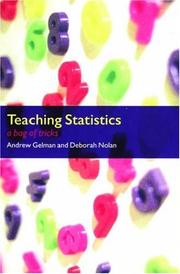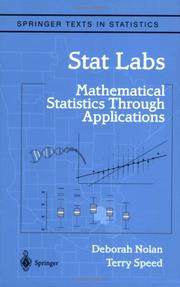| Listing 1 - 5 of 5 |
Sort by
|

ISBN: 0198572247 0198572255 9780198572244 9780198572251 Year: 2002 Publisher: Oxford: Oxford university press,
Abstract | Keywords | Export | Availability | Bookmark
 Loading...
Loading...Choose an application
- Reference Manager
- EndNote
- RefWorks (Direct export to RefWorks)
This exciting new volume takes a positive spin on the field of statistics. Statistics is seen by students as difficult and boring, however, the authors of this book have eliminated that theory. Teaching Statistics: A Bag Of tricks, brings together a complete set of examples, demonstrations and projects that not only will increase class participation but will help to eliminate any negative feelings toward the area of statistics.
Didactics of mathematics --- Mathematical statistics --- Statistics --- 519.2 --- 519.2 Probability. Mathematical statistics --- Probability. Mathematical statistics --- Study and teaching --- #SBIB:303H510 --- #SBIB:303H520 --- Methoden sociale wetenschappen: statistische technieken, algemeen --- Methoden sociale wetenschappen: techniek van de analyse, algemeen --- Study and teaching. --- Statistique --- Etude et enseignement --- Statistics - Study and teaching - Handbooks, manuals, etc.
Book
ISBN: 9780198785705 Year: 2017 Publisher: Oxford Oxford University Press
Abstract | Keywords | Export | Availability | Bookmark
 Loading...
Loading...Choose an application
- Reference Manager
- EndNote
- RefWorks (Direct export to RefWorks)
371.3:51 --- '371.3:51' 'Didactics of mathematics' --- 'Didactics of mathematics'
Book
ISBN: 1461478995 1461479002 Year: 2014 Publisher: New York, NY : Springer New York : Imprint: Springer,
Abstract | Keywords | Export | Availability | Bookmark
 Loading...
Loading...Choose an application
- Reference Manager
- EndNote
- RefWorks (Direct export to RefWorks)
Web technologies are increasingly relevant to scientists working with data, for both accessing data and creating rich dynamic and interactive displays. The XML and JSON data formats are widely used in Web services, regular Web pages and JavaScript code, and visualization formats such as SVG and KML for Google Earth and Google Maps. In addition, scientists use HTTP and other network protocols to scrape data from Web pages, access REST and SOAP Web Services, and interact with NoSQL databases and text search applications. This book provides a practical hands-on introduction to these technologies, including high-level functions the authors have developed for data scientists. It describes strategies and approaches for extracting data from HTML, XML, and JSON formats and how to programmatically access data from the Web. Along with these general skills, the authors illustrate several applications that are relevant to data scientists, such as reading and writing spreadsheet documents both locally and via GoogleDocs, creating interactive and dynamic visualizations, displaying spatial-temporal displays with Google Earth, and generating code from descriptions of data structures to read and write data. These topics demonstrate the rich possibilities and opportunities to do new things with these modern technologies. The book contains many examples and case-studies that readers can use directly and adapt to their own work. The authors have focused on the integration of these technologies with the R statistical computing environment. However, the ideas and skills presented here are more general, and statisticians who use other computing environments will also find them relevant to their work. Deborah Nolan is Professor of Statistics at University of California, Berkeley. Duncan Temple Lang is Associate Professor of Statistics at University of California, Davis and has been a member of both the S and R development teams.
XML (Document markup language) --- Computer science. --- Informatics --- Extendible Markup Language (Document markup language) --- eXtensible Markup Language (Document markup language) --- Mathematical statistics. --- Statistics. --- Statistics and Computing/Statistics Programs. --- Programming Languages, Compilers, Interpreters. --- Statistics, general. --- Science --- Statistical analysis --- Statistical data --- Statistical methods --- Statistical science --- Mathematics --- Econometrics --- Statistical inference --- Statistics, Mathematical --- Statistics --- Probabilities --- Sampling (Statistics) --- Document markup languages --- Statistics . --- Programming languages (Electronic computers). --- Computer languages --- Computer program languages --- Computer programming languages --- Machine language --- Electronic data processing --- Languages, Artificial --- R (Computer program language). --- GNU-S (Computer program language) --- Domain-specific programming languages --- Programming languages (Electronic computers)

ISBN: 0387989749 9786610010806 1280010800 0387227431 Year: 2000 Publisher: New York, NY : Springer New York : Imprint: Springer,
Abstract | Keywords | Export | Availability | Bookmark
 Loading...
Loading...Choose an application
- Reference Manager
- EndNote
- RefWorks (Direct export to RefWorks)
This book uses a model we have developed for teaching mathematical statistics through in depth case studies. Traditional statistics texts have many small numer ical examples in each chapter to illustrate a topic in statistical theory. Here, we instead make a case study the centerpiece of each chapter. The case studies, which we call labs, raise interesting scienti?c questions, and ?guring out how to answer a question is the starting point for developing statistical theory. The labs are substan tial exercises; they have nontrivial solutions that leave room for different analyses of the data. In addition to providing the framework and motivation for studying topics in mathematical statistics, the labs help students develop statistical thinking. We feel that this approach integrates theoretical and applied statistics in a way not commonly encountered in an undergraduate text. The Student The book is intended for a course in mathematical statistics for juniors and seniors. We assume that students have had one year of calculus, including Taylor series, and a course in probability. We do not assume students have experience with statistical software so we incorporate lessons into our course on how to use the software.
Mathematical statistics. --- Mathematical statistics --- 519.2 --- regressie-analyse --- wiskundige statistiek --- Mathematics --- Statistical inference --- Statistics, Mathematical --- Statistics --- Probabilities --- Sampling (Statistics) --- 519.2 Probability. Mathematical statistics --- Probability. Mathematical statistics --- Statistical methods --- Statistique mathématique --- EPUB-LIV-FT SPRINGER-B --- Statistics. --- Statistical Theory and Methods. --- Statistics . --- Statistical analysis --- Statistical data --- Statistical science --- Econometrics
Book
Year: 2008 Publisher: Beachwood, Ohio : Institute of Mathematical Statistics,
Abstract | Keywords | Export | Availability | Bookmark
 Loading...
Loading...Choose an application
- Reference Manager
- EndNote
- RefWorks (Direct export to RefWorks)
This volume is our tribute to David A. Freedman, whom we regard as one of the great statisticians of our time.
Mathematical statistics. --- Probabilities. --- Freedman, David,
| Listing 1 - 5 of 5 |
Sort by
|

 Search
Search Feedback
Feedback About UniCat
About UniCat  Help
Help News
News